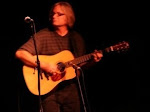
The prospect of spending a few days in any unfamiliar square-state city tends to inspire thoughts of, oh, I don’t know, catching up on my sleep, or finishing whatever 800-page novel I happen to be reading. Last month, while on tour with Joan Baez, my schedule called for spending three days in Lawrence, Kansas. The only thing I knew about Lawrence was that it is the home of the University of Kansas and, well, that’s what I could remember about Lawrence. The first day was our arrival—mid-morning after an overnight bus trip from Madison, Wisconsin. The second day we’d play in Columbia, Missouri, but return after the show to our Lawrence hotel, and the third day was a performance at the Liberty Theater in Lawrence. After stumbling out of the bus the morning of our arrival, I was pleased to discover our deluxe accommodations at the historic, comfortably stylish Eldridge Hotel, across the street from which was both a very promising espresso café and a suitably dusty used bookstore. OK, I thought, a few days in Lawrence could be quite pleasant.
What I’d forgotten was that Lawrence is home to Mass Street Music, one of the best guitar stores in the country. So, after a day of catching up on my sleep, and another filled with a bus ride, sound check, and another great show with Joan and company, etc., I finally remembered that when I’d met Mass Street Music owner Jim Baggett at Steve Kaufman’s Acoustic Kamp a couple of years ago, he’d invited me to come by any time I was in Lawrence. So I walked the seven or eight blocks down the street through a crowd of college-age St. Patrick’s Day revelers and found Mass Street Music in a cozy residential district.
At first glance, Mass Street looks like many a successful, well-organized music store, with a couple of large rooms full of keyboards, electric guitars, accessories, and sound equipment downstairs, and an acoustic room upstairs with a good complement of Taylors, Collings, Eastmans, Martins, and Goodalls. But what really distinguishes Mass Street, at least for guitar junkies, is Jim Baggett’s vintage expertise. He’s been collecting guitars for decades and he moonlights as a vintage-guitar expert for PBS’s Antiques Roadshow. Jim appeared while I was a making my way through a brace of very tasty Collings dreadnoughts, and after a few pleasantries, he said, “Wait here, I’ve got something to show you.” Believe me, any guitarist who hears Jim utter those words isn’t going anywhere.
Soon enough, Jim appeared with a couple of guitars from his personal collection—a luscious late-’30s D-18 that had the richest, fattest tone of any late-’30s D-18 I’d ever played and what he described as “the first D-28,” an amazing 12-fret, slot-head, rosewood dreadnought that sounded like nothing I’d ever played. Jim explained that it was actually the third D-28 ever made, but that the first two had never surfaced, so as far as anyone knew it was the first D-28 in existence, as close to the Holy Grail as any bluegrass-infused flatpicker like me is ever going to get. After playing it and the D-18 for as long as was seemly—I didn’t want to actually start drooling on the finish of these priceless gems—Jim showed me the rest of the repair shop, including a few more prewar dreads he was restoring and one of the cleanest early-’30s 000-28’s I’d ever seen. The back and sides looked liked they’d been hewn from the same log—not something Martin was all that particular about back then—and it was utterly pristine, as if it had rolled out of the Martin assembly room the day before. This wasn’t just a case of a kid in a candy store, but a chocoholic set loose in Willy Wonka’s factory.
So, yes, I now know exactly what there is to do in Lawrence, Kansas, thank you very much.
—Scott Nygaard
Photo (c) Anne Hamersky




